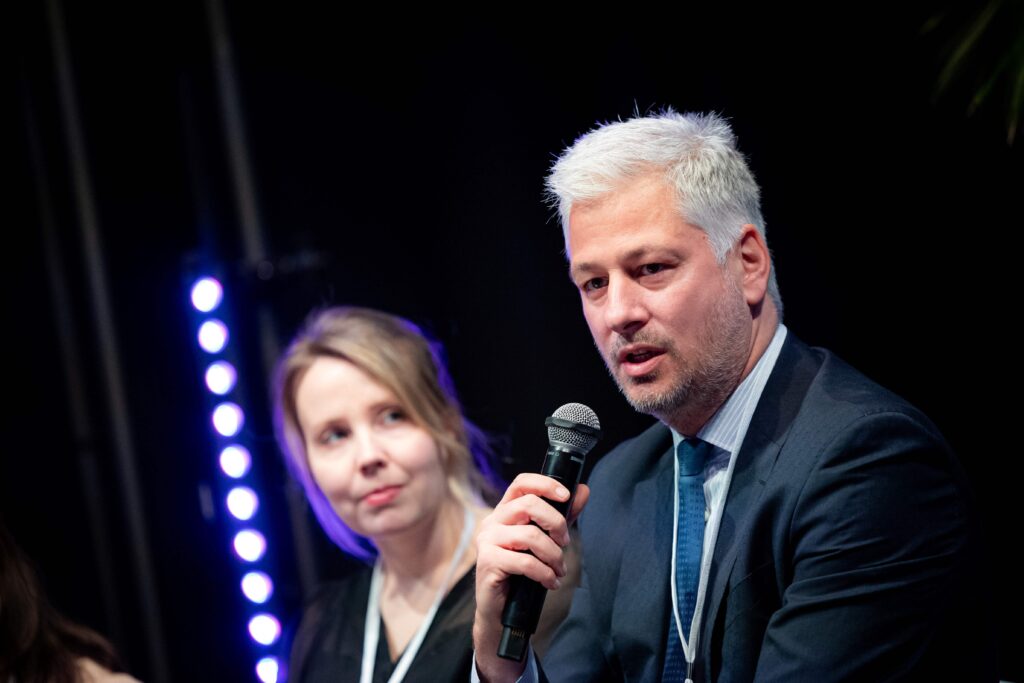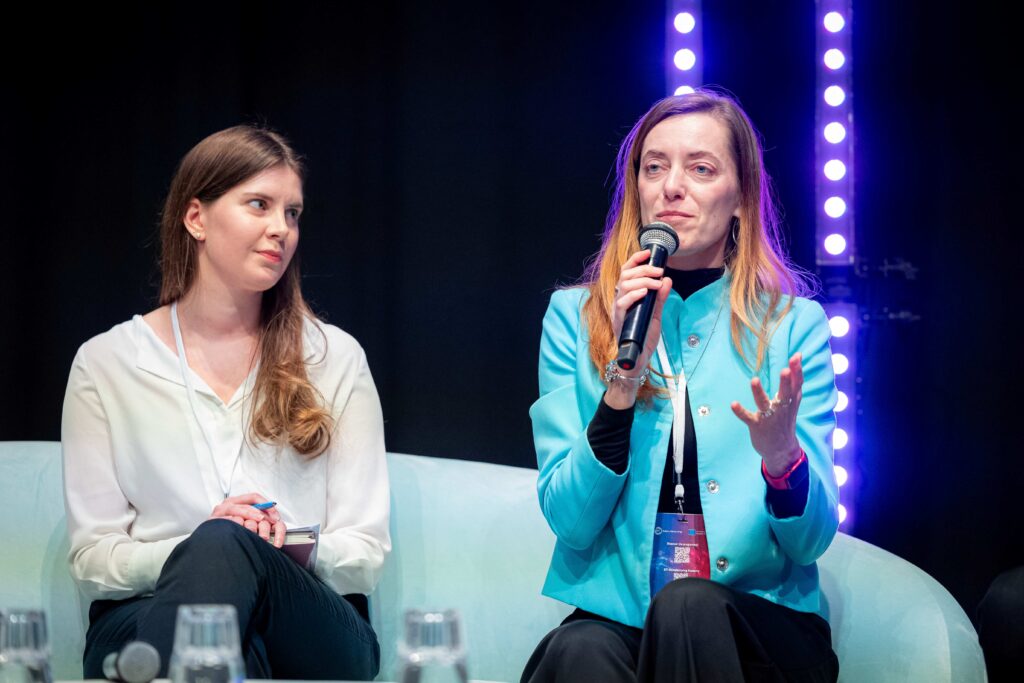Start small, think circular: How sustainability has become Europe’s competitive advantage
At InnoHive 2025, circularity and sustainability in manufacturing emerged not only as one of the dominant themes but as a call to action. Across panels, workshops and keynote discussions, industry leaders, policy advisors, entrepreneurs and sustainability experts converged to explore how manufacturers can comply with Europe’s ambitious green agenda – while turning compliance into a catalyst for transformation, innovation and growth, rather than a regulatory hurdle to overcome.
This focus on sustainability is no coincidence, as the EU Green Deal and the Corporate Sustainability Reporting Directive (CSRD) reshape the industrial landscape.
Reframing compliance as opportunity
The session “ESG & CSRD in Manufacturing – From Compliance to Competitive Edge”, led by David Kames, Innovation Lead at EIT Manufacturing, tackled head-on the growing expectation for transparency and accountability. Environmental, Social and Governance (ESG) and sustainability reporting, he argued, are fast becoming core business disciplines and far from being bureaucratic hoops, they offer frameworks to:
- Improve risk management
- Secure green finance
- Identify inefficiencies
- Strengthen supply chain trust
- Position manufacturers at the front of future-proof markets
Kames’s workshop underscored that the EU’s twin transition – digital and green – is deeply interlinked. As well as helping industry optimise manufacturing processes, digital tools, from artificial intelligence (AI) to digital twins, are also critical enablers of sustainability reporting.
It’s not about collecting more data. It’s about making that data visible, actionable and aligned with your decisions.
David Kames, Innovation Lead at EIT Manufacturing
A systemic approach to circularity
This narrative deepened during the plenary session “Industrial Evolution: Strategies for a Sustainable and Circular Future”, a high-level panel that brought together several voices from across Europe’s innovation ecosystem to assess what’s working, what’s missing and what must happen next. Moderator Karin Helmstaedt opened the panel with urgency: “We’re here not just to talk about ideas, but to understand what’s being implemented – and what still needs to change.” It was a call to action that the panel embraced with gusto.
As Xavier Baillard, Director of Inno2Market EIT Manufacturing, reminded attendees, “Circularity isn’t just a recycling issue. It’s a question of infrastructure, design, logistics and business models.”
Riikka Virkkunen, Professor of Practice at VTT, stressed that sustainable manufacturing must be approached through a systems lens.
It’s not just about cleaner production. It’s about redesigning entire business models and redefining how we measure value.
Riikka Virkkunen, Professor of Practice at VTT
Virkkunen emphasised the importance of early-stage product development in shaping downstream sustainability outcomes and called for circular thinking to be embedded at the design phase.
Konstantinos Chatzifotis, EU Affairs Manager at Motor Oil Group, provided a powerful case study of transition in a legacy sector. Describing a EUR 4 billion energy transformation strategy that includes green hydrogen, sustainable aviation fuels (SAFs) and circular carbon capture, he spoke candidly about the tension between perception and reality in traditional energy. “As an energy leader in South-East Europe, we are now pushing the transition forward while enhancing energy security and providing innovative products to our customers”, he added.
Elina Pihlajamaki, Policy Advisor in E3G’s Clean Economy programme, delivered a policy perspective, outlining four key levers for the success of Europe’s Clean Industrial Deal:
- Establish lead markets for low-carbon products using procurement and labelling.
- Expand grid capacity to support electrification.
- Strengthen EU-level funding to ensure cross-border competitiveness.
- Improve coordination across EU and national levels.
Startups provided a reality check. Susanna Partanen, CEO and Co-Founder of cleantech startup Woamy, shared her frustration with slow corporate onboarding timelines. “We’ve gone from lab to pilot machine, but in order to reach commercial scale, we need both more capital and customers – and one depends on the other. We need faster paths to certification and a more predictable path to customers.”

Susanna Partanen and Konstantinos Chatzifotis at InnoHive 2025. Photo credit (c) Xavier Lejeune
In five years, I want to see more cleantech initiatives and startups driving economic growth.
Susanna Partanen, CEO and Co-Founder of Woamy
Jana Budkovskaja, Venture Partner at Beamline Accelerator, echoed this, highlighting that impactful innovation must deliver value beyond compliance.
The most successful cleantech solutions save companies time, money and emissions. That’s what makes them stick.
Jana Budkovskaja, Venture Partner at Beamline Accelerator
Budkovskaja also stressed the importance of deeper interconnectivity across the European innovation ecosystem, between corporates, regulators, funders and startups, highlighting a successful geothermal project in Estonia that thrived due to grassroots collaboration and quick communication between all parties. “The challenge now is: how do we replicate that agility across the EU?”

Elina Pihlajamaki and Jana Budkovskaja at InnoHive 2025. Photo credit (c) Xavier Lejeune
Circularity in action: Mindset shifts and practical steps
In the workshop “Inverting realities – Rethinking manufacturing for circularity”, participants were led through the practical, sometimes uncomfortable, process of understanding their own assumptions and opportunities related to circularity and their own businesses. Circularity specialists from Innoboost, Christiaan Kraaijenhagen and Sandra Horlings, used a small steel door handle producer as a live case study to demonstrate how even small and medium-sized enterprises (SMEs), currently outside direct CSRD scope, are being pulled into sustainability obligations through customer and supply chain demands.
Attendees learned how core circular strategies – reduce, reuse, rethink, regenerate, recycle – could be applied to product design, sourcing, logistics and market differentiation. The emphasis was on agency and action.
Whether navigating geopolitical volatility, digital transformation, or climate disruption, the question remains the same: How do you future-proof your business? For manufacturers, the answer is becoming clear — start now, start small and think circular.
All the discussions concluded: ‘Sustainability is no longer a moral add-on or a regulatory burden – it is the strategy’.

